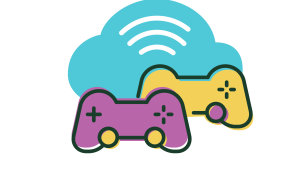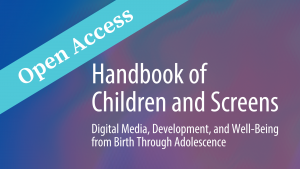
Video gaming has become part of the fabric of youth daily life, with 85% of teens in the United States reporting playing video games in 2024 (and 41% daily).1 With several decades of research available of video gaming and its potential effects on child health, what’s the verdict? Is video gaming beneficial or harmful to mental and physical health for youth and adolescents, and what aspects of video gaming may change these effects? How can parents evaluate their children’s game use to determine whether there may be a problem, and what is the best way to engage and guide youth to healthy use?
On This Page
It’s More Than “Just a Game”
Gaming is an important part of many children’s lives. It may be easy to dismiss games as “just games” and relegate them to the zone of something “childish,” says Douglas Gentile, PhD, Distinguished Professor in Liberal Arts and Sciences, Department of Psychology at Iowa State University. However, this minimizes the fact that games have become an art form that can effect change in both adults and children, and should be taken seriously, he says.
Possible impacts from gaming include negative impacts such as reduced school performance, increased risk for obesity, video-induced seizures, gaming addiction, aggressive thoughts and behaviors, repetitive stress injuries, and other psychological and physical effects, says Gentile. More positive impacts can include increased empathy and helpful/cooperative behavior, as well as improved spatial and visual attentional faculties. These impacts can depend on the amount of time spent gaming, content and structure of the game being played, in- and out-of-game contexts, and the physical mechanics of game play.
“In neuroscience a well-founded principle is that our brains have this phenomena called ‘experience-dependent plasticity,’ and that means that experiences change your brain and it does so at every level – the structure, the chemistry, the function, physiology, all those aspects of your brain are constantly changing in response to experiences,” says Adam Gazzaley, MD, PhD, Founder and Executive Director, Neuroscape; David Dolby Distinguished Professor of Neurology, Physiology and Psychiatry, University of California, San Francisco. “This is the entire basis of learning. And in that sense, video games are just another type of experience with their own details, but not in some ways different than education itself as a type of experience. And therefore it can be thought of as a tool to change your brain intentionally.”
Evaluate Quality Of Game Play vs Quantity For Mental Health
“There are lots of ways that games can affect mental health for better and for worse,” says Nick Ballou, PhD, Postdoctoral Researcher at Oxford Internet Institute. “Research shows that play time is less important than the quality of that play,” he notes. “There are people like speedrunners or streamers that have really healthy, positive relationships with games and gaming communities despite really high play time.”
When evaluating youth game play to determine whether it falls into a “healthy” use or “problematic” use, Ballou suggests looking at factors such as:
- Business model/monetization features – Are there gambling or loot box features that encourage problematic play or behaviors?
- Genre of game – What type of game is it — for example, a story-focused role-playing game, a fast-paced strategy game, a creative simulation or building game, or something else?
- Mode of game – Is the game being played as a team or in solitary mode? Are there randomized elements?
- Content of game – What themes does the game include? For example, sexualized characters, drug use or gambling, fantasy violence, and so forth.
- When the game is being played – Is the game being played after school/weekends or before school? (Some research indicates that before-school gaming is associated with lower school performance.)
- What the play is displacing – Is the child gaming to the exclusion of homework, reading a book, or other activities available to them?
- Physical position of play – What is the body doing while in video game play?
- Social context of play – What communities or relationships is the gamer engaging in through video play?
- Play style – What is the child doing in the game? What kind of roles are they adopting in the game? Are they taking a more of a leadership role or a follower role, or are they playing a support role?
- Purpose of Play – What is the gamer trying to get out of playing the game?
- Individual Factors – What are the identities or personality traits of the gamer that affects how they experience game play?
- Emotional factors – How does the game make the player feel during and after play?
Foster Self-Reflection And Emotional Awareness About Game Play
As a parent or caregiver, it can be difficult to get your child to engage with the self-reflective questions above and start building the skills for more healthy gaming. One helpful place to start is through demonstrating transparency and reflection about your own game play, says Ballou. “I find this to be a really interesting and useful way to train your children, to be reflective about their media use and building that kind of self-awareness – what they want out of it, whether they’re actually getting that out of it, and whether they’re maybe straying into a realm where it might become problematic.”
However, the inability to detect or be aware of one’s own emotional state is something common to many problematic gamers, says Alok Kanojia, MD, MPH, President and Co-Founder of Healthy Gamer. Many parents and educators are attempting to deal with problematic gaming when the child or adolescent may have other significant emotional turmoil affecting their ability to assess their game play. (See What to Do About Problematic Gaming)
Acknowledge Benefits Of Healthy Gaming
While problematic gaming is real, there is research that supports the claim that healthy gaming can provide actual benefits to players, says Ballou. “Games are a great way to feel a sense of meaning and appreciation with an emotional connection to characters. They’re a great way to relieve stress and be part of a pleasant environment and escape from kind of a less-pleasant reality from time to time and in moderation. They are ways to satisfy our need to grow and develop and build new skills. Games are a way to learn effectively.”
Gaming also can provide significant opportunities for relationship and community-building, especially for more marginalized and vulnerable youth populations, says Kishonna Gray, PhD, Associate Professor at University of Kentucky.
Protect Children With Effective Monitoring
There are several approaches to monitoring children’s media, such as co-playing, setting limits on time and/or content, but the most effective approach to successful media monitoring as shown by extensive research is an approach called “active mediation”, according to Gentile.
Have a discussion with your child about their individual preferences, why they do or do not like certain things, why you want them to see or avoid seeing certain things, and whose point of view is or isn’t being shown, says Gentile. “‘What effects could playing this type of game have on people’?’ What effects do you notice on yourself?’ You’re getting them to reflect critically on the media. The literature is clear that [active mediation] is a powerful protective factor for children, even better than limit setting,” explains Gentile.
Setting Basic Limits Works
Establishing early on with children that there are basic constraints around fun experiences like video gaming is important to lay the foundation for healthy life routines and structures, says Gazzaley. “I explain to my three-year-old that everything we do has restrictions and limitations. Even the things we think are great, like eating and being at school and exercising. That’s just the way life is. You need to put constraints around the good things as well as the bad things and then have a structure to your day that makes sense.”
Research indicates that there are substantial benefits of setting basic limits on gaming and screen media time, even if it may not seem like it in the short term, says Gentile, who cites a study of 1400 families of third to fifth graders that indicated physical health, social wellness, and school performance benefits associated with family limits on screen time. “We followed them across a school year. If parents set limits on the amount and content of screen media at the beginning of the school year, you saw some immediate effects that the kids were consuming less total screen time, and they were also exposed to less violent media. When we followed these same children out to the end of the school year, those whose parents had set limits on amount and content by at the beginning of the school year, they were getting better sleep, which in turn related to lower weight gains or lower risk for obesity. They were getting better grades in school. They were more prosocial and less aggressive in their behaviors as rated by teachers in the classroom.”
Just setting basic limits does seem to be a powerful buffer for children’s health and wellness based on this research, says Gentile. “Data like this show that it’s worth having rules and it’s worth holding them firm because it has a powerful protective factor effect.”
Be Wary Of Monetization Or Gambling Features That Drive Over-Engagement
While there are many dimensions to what may make the content of a game more harmful than beneficial, there are certain features using monetization or gambling strategies that are commonly understood to have negative effects on gamers, says Ballou. “For example, you buy a subscription for a game for a month or three months, and then the game gives you rewards on a schedule. The more you play, the more rewards you earn. If you don’t play a sufficient amount of time or log in every day for that period for which you have the subscription, you will lose out on those rewards,” he explains.
With these sorts of features, you’ll find many players saying things like “I actually don’t really want to play this game right now, but I feel like I have to,” says Ballou. Any design feature that makes a player feel that they have to do something they don’t want to do because of investment or gamification should be reined in where possible, he suggests.
Gazzaley agrees. “There are some game mechanics that are very close to what we would call gambling mechanics, some reinforcement strategies that are just considered unhealthy, and that’s something that we should definitely monitor. But, at the end of the day, it’s the delivery of these that really has to be monitored,” he says.
Signs Of A Problem
The first thing parents should do if they suspect a problem is to trust their instinct, says Kanojia. “Parental instincts have been honed over millions of years of evolution,” he says, “If you think something is wrong, that’s the first reason that you should investigate.”
In the clinical setting, the key symptom to look for in a child who potentially has a gaming addiction is impairment to function, says Kanojia. How can you spot impairments to function? Kanojia and Gentile suggest evaluating the following:
- Is the behavior interfering with the ability to do schoolwork?
- Is it interfering with professional lives (if adult)?
- Is it interfering with physical health?
- Is it interfering with our mental health? Are moods worse?
- Is it interfering with our relationships?
- Is there a substantial change to the personality?
- Is the child engaging less with friends or only seeking friends that also game?
- Is there increased isolation and withdrawal into games and gaming behavior?
- Is the child giving up other activities they enjoy like sports or music or other after school activities?
If the answers to several of the above questions are “yes”, this is when gaming has likely crossed the line into an addiction, says Kanojia.
What To Do About Problematic Gaming
Break The Cycle Of Managing Negative Emotions Through Gaming
“Playing a video game, much like many other addictive substances or behaviors, suppress our amygdala and our limbic system,” says Kanojia. “These are the parts of our brain that experience negative emotions. What we see with unhealthy gaming is a cycle of, let’s say I’m being bullied at school, let’s say I’m not doing great in my classes, so how do I manage those negative emotions? I’m going to shut them off through video gaming. And then this creates a vicious cycle.”
Although there is nothing necessarily wrong with using media as a coping strategy, this can tip into overreliance that fosters problematic gaming, says Gentile, who describes how common it can be for a gaming problem to be masked by the other functional problems that come with addiction, especially for new college students. “We’ve got lots of first year freshmen in a dorm with a bunch of other boys who also like to play games. They stay up really late playing and then they’re tired in class, so they don’t do as well on the test. To deal with the stress of not doing so well, they play more games and then they are so tired, they don’t even bother to go to class, and they start failing, to which their response is to play more games. If they bother to go down to student counseling services, they walk in, they say,’ I’m worried about my grades.’ ‘The therapist very appropriately asks grade-relevant questions and doesn’t ask about games because the patient didn’t present with a problem about games. The patient never talks about games because to him, they’re part of the solution. And so no one asks about the actual issue and these students just flunk out.”
Work Collaboratively With Your Child To Curb Problem Gaming
Once you have identified a child has problematic or addictive gaming habits, Kanojia suggests avoiding the classic power struggle between immediate parental restriction of game access and youth rebellion, and instead form an alliance with your child to address the problem together.
“The one lesson I’ve learned practicing addiction psychiatry is that you can’t force sobriety on someone else,” explains Kanojia. “Our whole approach is helping parents connect with their child. Parents need to learn a new communication style, get on the same page as their child, and then do healthy boundary setting. The real paradox here is that a lot of parents will really do things that they think are good, which is actually making the problem worse.”
Gray also finds success in having parents and children enter a “compromised negotiation space” to engage with problem gaming. “The young folks identify what their needs are – their needs are mostly wants, they just want to play the game and engage with their friends,” she says. After the parents lay out their needs, they can work together to find a compromise that addresses both sets of needs. This process will help youth feel empowered and develop decision-making skills while defusing child-parent tension and the pressure for the parents to feel they need to control or arrive at the solutions themselves.
Ask Questions To Find Common Ground
“What we really try to do is we try to emphasize restraint over restriction” in clinical practice, notes Kanojia. To work towards establishing boundaries that are aligned to accomplishing both child and parent goals, he recommends parents use evidence-based methods like motivational interviewing. This involves asking questions like “Why do you want to play this game? What is enjoyable to you about it? What’s challenging in the real world? What do you like in the real world?”
The answers to these questions will help establish common ground and understanding such that boundaries can be set that make sense for the individual child. The parent is able to respond with validation and solutions to the child’s experience. “As a parent, you can say, ‘Okay, I get that you want to play with your friends. I get that everyone is playing Fortnite. That’s totally fine. I want to support that. At the same time, it is my job and responsibility as a parent to make sure that you go to bed, or get sufficient rest, and take care of the things that you need to do. How can we work together so that you can have fun and we can get these kinds of things sorted out that need to be sorted out like school or physical health or whatever?’ We find that that’s a really good place to start,” says Kanojia.
Parents can use the questions in the section on evaluating quality of game play vs. quantity for mental health to help kids understand the effects certain game play may be having on them. “Experiences drive plasticity. And plasticity is heightened in childhood and all experiences are going to have large effects and the effects of the games are going to depend upon the features of the game play,” says Gazzaley. “What are the mechanics? What is the content? How long are you doing it? What are your intentions about doing it and the structure of it?”
Aim For Healthy Gaming vs No Gaming
In treating most addictions, the goal is usually total sobriety, says Kanojia, who advocates a more measured approach with gaming addictions. “Our approach at Healthy Gamer is to help people become healthy gamers. When we’re looking at these technologies, these are closer to behavioral addictions” where the goal is less total abstinence and more about a healthier relationship to the behavior.
Be Realistic About The Pace Of Change
Parents anxious to address a gaming problem are often overambitious in their desires for the time required to establish change, says Kanojia. “Parents are so terrified that every month that goes by, every year that goes by, they feel ‘my child is falling further and further and further behind,’” he says.
“What we recommend is the ‘25% Rule,’ which is: take where you want to go, take where you are, find a halfway point, and then find the halfway point between the halfway point and where you are. Start small and start winning together. Once you have victories, then you can start to become more ambitious over time because dealing with something like an addiction, the time scale is very long. We strongly, strongly recommend starting small and going for wins.”
Treat The Individual
Children struggling with gaming problems and possibly other comorbid conditions like depression or anxiety must be treated as individuals first and foremost, says Gazzaley. “It has to be disentangled in a very personal way. Being a healthcare professional myself, I’m always thinking about the fact that there is great value to population research, but there’s also just the importance of thoughtful time between someone that has a lot of experience in dealing with these situations and the individual that’s suffering” in order to get them the help they need.
Don’t Give Up Hope
It can feel overwhelming as a parent dealing with children who seem to be fixated on game play. “No one has ever had to parent this generation of kids before. The good news is that there is a lot that you can do, and the interesting paradoxical thing that we see is that as you work on this problem with your child over time, we actually see a strengthening of the relationship,” says Kanojia. “The good news is that there are a lot of people working really, really hard and we do see really, really good outcomes. So don’t give up hope and maybe game a little bit with your kid.”
Considerations For Neurodiverse Youth
Gaming can be a “double-edged” sword for children with ADHD or autism, says Kanojia. Some children on the autism spectrum can struggle to form connections, because they may not be able to read tone and may prefer structured environments. Gaming can be particularly attractive to these youth because “the rules are laid out. The teams get set. You don’t have to worry about body language and tone. You can communicate via typing out messages,” Kanojia explains. Neurodivergent youth can find particular success in the realm of gaming, and e-sports professionals are up to 5x more likely to have ADHD than the general population.
In this sense gaming environments can be beneficial and protective to youth on the autism spectrum, providing enjoyment and fulfillment, and yet it can also be particularly damaging, according to Kanojia, who cites research indicating that playing certain types of video games can worsen things like behavioral tantrums and outbursts. Coupled with the high incidence of comorbidity of ADHD and depression (70% of children who have ADHD early in life will develop depression later), parents of neurodivergent youth should be particularly vigilant in monitoring their individual child for signs of negative effects like impairments to other life functions from problematic gaming, says Kanojia.
Considerations For Youth With Physical Disabilities
Physically disabled youth have historically been excluded from discussion and consideration in gaming spaces, says Gray, and parents of these youth may think there aren’t any opportunities for them to join in healthy gaming. This is changing, and Gray cites AbleGamers and Quad Gods as two groups who are “thinking about accessible technologies – how the technology of the space keeps them out and what they need to participate and engage.”
Gamers with disabilities may face unique barriers such as financial hurdles to purchasing specific controllers and other accessories needed for accessibility, as well as face exclusionary practices at gaming events that can effectively prohibit wheelchair users due to accessibility, Gray notes. On the other hand, gaming has also effectively been used as a tool to support integration of students and youth with disabilities.
1Gottfried, J., & Sidoti, O. (2024, May 9). Teens and Video Games Today. Pew Research.











